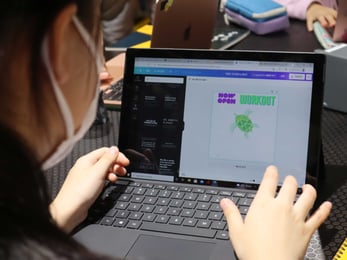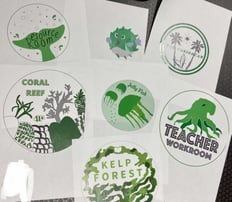
Grade 9 students were lucky enough this year to be able to work as designers for a real client while working through the MYP Design Cycle. This was a rare opportunity and an extremely valuable experience for them. It all started when the Primary School needed logos for their class sections. This gave Gr. 9 a chance to learn how the design process worked when required to meet an actual client. It was a challenge to work within the client's restraints, desires, and requirements and make the product they wanted. But these challenges are precisely what a professional designer would experience in the real world.
The first challenge was learning logo design, and the Gr. 9 designers worked hard at their research and analysis. They inquired into what made a good logo and explored what would make a less effective logo. They collected samples that fit both these criteria and analyzed aspects of them. This inquiry phase meant they were informed and prepared to meet the challenge of becoming a professional logo designer.
Each student had a theme to work under. From pufferfish and otters to orcas and octopi, the Gr. 9 sketchbooks were teeming with underwater life! The client required everything to be in a color palette of grey and green, and initially, this challenged the students and caused consternation as they came to terms with designing under these restrictions. But the restraints pushed them to refine and work through other approaches for representing their logo - with excellent results.
They also learned about moving their sketches from paper to digitalization and, through this, delved into the world of professional graphics software. Some students had experience using Gravit Designer, an online free platform, but Adobe Illustrator is the professional software used in design studios to create logos. Many students took up the challenge to learn this new software (licensed by the school) and developed many new and transferable computer skills. They used design thinking to work through iterations of their designs until they achieved a printed sample they could show to the client. From there, they received feedback from the client to make changes and improvements so the logos would be more successful with their target audience - the Primary School students!
 The Gr. 9 students made the thousands of decisions that a designer must make throughout the creative process of creating a product for a client and immersed themselves in the methods of design thinking - a skill that will serve them in many areas of their education as they learn to iterate and improve their ideas as they work through a project. The Primary teachers voted on the collection of logos they would use, and as a result, the Primary hallway came alive with depictions of sea-scape signage, indicating which class is which. Overall, this can be considered a very successful design job for both clients and designers as they were both pleased with their professional-looking logos!
The Gr. 9 students made the thousands of decisions that a designer must make throughout the creative process of creating a product for a client and immersed themselves in the methods of design thinking - a skill that will serve them in many areas of their education as they learn to iterate and improve their ideas as they work through a project. The Primary teachers voted on the collection of logos they would use, and as a result, the Primary hallway came alive with depictions of sea-scape signage, indicating which class is which. Overall, this can be considered a very successful design job for both clients and designers as they were both pleased with their professional-looking logos!




 The Gr. 9 students made the thousands of decisions that a designer must make throughout the creative process of creating a product for a client and immersed themselves in the methods of design thinking - a skill that will serve them in many areas of their education as they learn to iterate and improve their ideas as they work through a project. The Primary teachers voted on the collection of logos they would use, and as a result, the Primary hallway came alive with depictions of sea-scape signage, indicating which class is which. Overall, this can be considered a very successful design job for both clients and designers as they were both pleased with their professional-looking logos!
The Gr. 9 students made the thousands of decisions that a designer must make throughout the creative process of creating a product for a client and immersed themselves in the methods of design thinking - a skill that will serve them in many areas of their education as they learn to iterate and improve their ideas as they work through a project. The Primary teachers voted on the collection of logos they would use, and as a result, the Primary hallway came alive with depictions of sea-scape signage, indicating which class is which. Overall, this can be considered a very successful design job for both clients and designers as they were both pleased with their professional-looking logos!